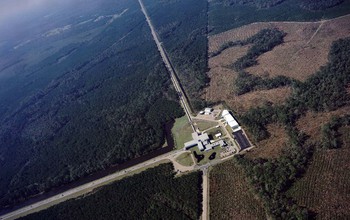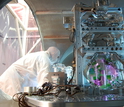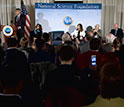News Release 16-015
Gravitational waves detected 100 years after Einstein's prediction
LIGO opens new window on the universe with observation of gravitational waves from colliding black holes

Aerial view of the LIGO laboratory in Louisiana.
February 11, 2016
This material is available primarily for archival purposes. Telephone numbers or other contact information may be out of date; please see current contact information at media contacts.
For the first time, scientists have observed ripples in the fabric of spacetime called gravitational waves, arriving at Earth from a cataclysmic event in the distant universe. This confirms a major prediction of Albert Einstein's 1915 general theory of relativity and opens an unprecedented new window to the cosmos.
Gravitational waves carry information about their dramatic origins and about the nature of gravity that cannot be obtained from elsewhere. Physicists have concluded that the detected gravitational waves were produced during the final fraction of a second of the merger of two black holes to produce a single, more massive spinning black hole. This collision of two black holes had been predicted but never observed.
The gravitational waves were detected on Sept. 14, 2015, at 5:51 a.m. EDT (09:51 UTC) by both of the twin Laser Interferometer Gravitational-wave Observatory (LIGO) detectors, located in Livingston, Louisiana, and Hanford, Washington. The LIGO observatories are funded by the National Science Foundation (NSF) and were conceived, built and are operated by the California Institute of Technology (Caltech) and the Massachusetts Institute of Technology (MIT). The discovery, accepted for publication in the journal Physical Review Letters, was made by the LIGO Scientific Collaboration (which includes the GEO Collaboration and the Australian Consortium for Interferometric Gravitational Astronomy) and the Virgo Collaboration using data from the two LIGO detectors.
Based on the observed signals, LIGO scientists estimate that the black holes in this event were about 29 and 36 times the mass of the sun, and the event took place 1.3 billion years ago. About three times the mass of the sun was converted into gravitational waves in a fraction of a second -- with a peak power output about 50 times that of the whole visible universe. By looking at the time of arrival of the signals -- the detector in Livingston recorded the event 7 milliseconds before the detector in Hanford -- scientists can say that the source was located in the Southern Hemisphere.
According to general relativity, a pair of black holes orbiting around each other lose energy through the emission of gravitational waves, causing them to gradually approach each other over billions of years, and then much more quickly in the final minutes. During the final fraction of a second, the two black holes collide at nearly half the speed of light and form a single, more massive black hole, converting a portion of the combined black holes' mass to energy, according to Einstein's formula E=mc2. This energy is emitted as a final strong burst of gravitational waves. These are the gravitational waves that LIGO observed.
The existence of gravitational waves was first demonstrated in the 1970s and 1980s by Joseph Taylor Jr., and colleagues. In 1974, Taylor and Russell Hulse discovered a binary system composed of a pulsar in orbit around a neutron star. Taylor and Joel M. Weisberg in 1982 found that the orbit of the pulsar was slowly shrinking over time because of the release of energy in the form of gravitational waves. For discovering the pulsar and showing that it would make possible this particular gravitational wave measurement, Hulse and Taylor were awarded the 1993 Nobel Prize in Physics.
The new LIGO discovery is the first observation of gravitational waves themselves, made by measuring the tiny disturbances the waves make to space and time as they pass through the Earth.
"Our observation of gravitational waves accomplishes an ambitious goal set out over five decades ago to directly detect this elusive phenomenon and better understand the universe, and, fittingly, fulfills Einstein's legacy on the 100th anniversary of his general theory of relativity," says Caltech's David H. Reitze, executive director of the LIGO Laboratory.
The discovery was made possible by the enhanced capabilities of Advanced LIGO, a major upgrade that increases the sensitivity of the instruments compared to the first generation LIGO detectors, enabling a large increase in the volume of the universe probed -- and the discovery of gravitational waves during its first observation run. NSF is the lead financial supporter of Advanced LIGO. Funding organizations in Germany (Max Planck Society), the U.K. (Science and Technology Facilities Council, STFC) and Australia (Australian Research Council) also have made significant commitments to the project.
Several of the key technologies that made Advanced LIGO so much more sensitive were developed and tested by the German UK GEO collaboration. Significant computer resources were contributed by the AEI Hannover Atlas Cluster, the LIGO Laboratory, Syracuse University and the University of Wisconsin-Milwaukee. Several universities designed, built and tested key components for Advanced LIGO: The Australian National University, the University of Adelaide, the University of Florida, Stanford University, Columbia University of the City of New York and Louisiana State University (LSU).
"In 1992, when LIGO's initial funding was approved, it represented the biggest investment NSF had ever made," says France Córdova, NSF director. "It was a big risk. But NSF is the agency that takes these kinds of risks. We support fundamental science and engineering at a point in the road to discovery where that path is anything but clear. We fund trailblazers. It's why the U.S. continues to be a global leader in advancing knowledge."
LIGO research is carried out by the LIGO Scientific Collaboration (LSC), a group of more than 1,000 scientists from universities around the United States and in 14 other countries. More than 90 universities and research institutes in the LSC develop detector technology and analyze data; approximately 250 students are strong contributing members of the collaboration. The LSC detector network includes the LIGO interferometers and the GEO600 detector. The GEO team includes scientists at the Max Planck Institute for Gravitational Physics (Albert Einstein Institute, AEI), Leibniz Universität Hannover, along with partners at the University of Glasgow, Cardiff University, the University of Birmingham, other universities in the United Kingdom and the University of the Balearic Islands in Spain.
"This detection is the beginning of a new era: The field of gravitational wave astronomy is now a reality," says Gabriela González, LSC spokesperson and professor of physics and astronomy at Louisiana State University.
LIGO was originally proposed as a means of detecting gravitational waves in the 1980s by Rainer Weiss, professor of physics, emeritus, from MIT; Kip Thorne, Caltech's Richard P. Feynman Professor of Theoretical Physics, emeritus; and Ronald Drever, professor of physics, emeritus, also from Caltech.
"The description of this observation is beautifully described in the Einstein theory of general relativity formulated 100 years ago and comprises the first test of the theory in strong gravitation. It would have been wonderful to watch Einstein's face had we been able to tell him," says Weiss.
"With this discovery, we humans are embarking on a marvelous new quest: The quest to explore the warped side of the universe -- objects and phenomena that are made from warped spacetime. Colliding black holes and gravitational waves are our first beautiful examples," says Thorne.
Virgo research is carried out by the Virgo Collaboration, consisting of more than 250 physicists and engineers belonging to 19 different European research groups: six from Centre National de la Recherche Scientifique (CNRS) in France; eight from the Istituto Nazionale di Fisica Nucleare (INFN) in Italy; two in the Netherlands with Nikhef; the Wigner RCP in Hungary; the POLGRAW group in Poland; and the European Gravitational Observatory (EGO), the laboratory hosting the Virgo detector near Pisa in Italy.
Fulvio Ricci, Virgo spokesperson, notes that: "This is a significant milestone for physics, but more importantly merely the start of many new and exciting astrophysical discoveries to come with LIGO and Virgo."
Bruce Allen, managing director of the Max Planck Institute for Gravitational Physics adds: "Einstein thought gravitational waves were too weak to detect, and didn't believe in black holes. But I don't think he'd have minded being wrong!"
"The Advanced LIGO detectors are a tour de force of science and technology, made possible by a truly exceptional international team of technicians, engineers and scientists," says David Shoemaker of MIT, the project leader for Advanced LIGO. "We are very proud that we finished this NSF-funded project on time and on budget."
At each observatory, the 2 1/2-mile (4-km) long, L-shaped LIGO interferometer uses laser light split into two beams that travel back and forth down the arms (4-foot diameter tubes kept under a near-perfect vacuum). The beams are used to monitor the distance between mirrors precisely positioned at the ends of the arms. According to Einstein's theory, the distance between the mirrors will change by an infinitesimal amount when a gravitational wave passes by the detector. A change in the lengths of the arms smaller than one-ten-thousandth the diameter of a proton (10-19 meter) can be detected.
"To make this fantastic milestone possible took a global collaboration of scientists -- laser and suspension technology developed for our GEO600 detector was used to help make Advanced LIGO the most sophisticated gravitational wave detector ever created," says Sheila Rowan, professor of physics and astronomy at the University of Glasgow.
Independent and widely separated observatories are necessary to determine the direction of the event causing the gravitational waves, and also to verify that the signals come from space and are not from some other local phenomenon.
Toward this end, the LIGO Laboratory is working closely with scientists in India at the Inter-University Centre for Astronomy and Astrophysics, the Raja Ramanna Centre for Advanced Technology, and the Institute for Plasma to establish a third Advanced LIGO detector on the Indian subcontinent. Awaiting approval by the government of India, it could be operational early in the next decade. The additional detector will greatly improve the ability of the global detector network to localize gravitational-wave sources.
"Hopefully this first observation will accelerate the construction of a global network of detectors to enable accurate source location in the era of multi-messenger astronomy," says David McClelland, professor of physics and director of the Centre for Gravitational Physics at the Australian National University.
-NSF-
-
The LIGO detector in Washington.
Credit and Larger Version -
A technician works on one of LIGO's optics.
Credit and Larger Version -
View Video
Researchers at NSF press conference announce direct observation of gravitational waves.
Credit and Larger Version
Media Contacts
Ivy F. Kupec, NSF, 703-292-8796, email: ikupec@nsf.gov
Kimberly Allen, MIT, 617-253-2702, email: allenkc@mit.edu
Kathy Svitil, Caltech, 626-676-7628, email: ksvitil@caltech.edu
Susanne Milde, GEO600, +49 331 583 93 55, email: milde@mildemarketing.de
Fulvio Ricci, VIRGO Collaboration, +39 06 49914261, email: fulvio.ricci@roma1.infn.it
Terry O'Connor, UK Science and Technology Facilities Council, +44 1793 442006, email: terry.o'connor@stfc.ac.uk
Related Websites
LIGO Special Report: http://www.nsf.gov/news/special_reports/ligoevent/
The U.S. National Science Foundation propels the nation forward by advancing fundamental research in all fields of science and engineering. NSF supports research and people by providing facilities, instruments and funding to support their ingenuity and sustain the U.S. as a global leader in research and innovation. With a fiscal year 2023 budget of $9.5 billion, NSF funds reach all 50 states through grants to nearly 2,000 colleges, universities and institutions. Each year, NSF receives more than 40,000 competitive proposals and makes about 11,000 new awards. Those awards include support for cooperative research with industry, Arctic and Antarctic research and operations, and U.S. participation in international scientific efforts.
Connect with us online
NSF website: nsf.gov
NSF News: nsf.gov/news
For News Media: nsf.gov/news/newsroom
Statistics: nsf.gov/statistics/
Awards database: nsf.gov/awardsearch/
Follow us on social
Twitter: twitter.com/NSF
Facebook: facebook.com/US.NSF
Instagram: instagram.com/nsfgov



